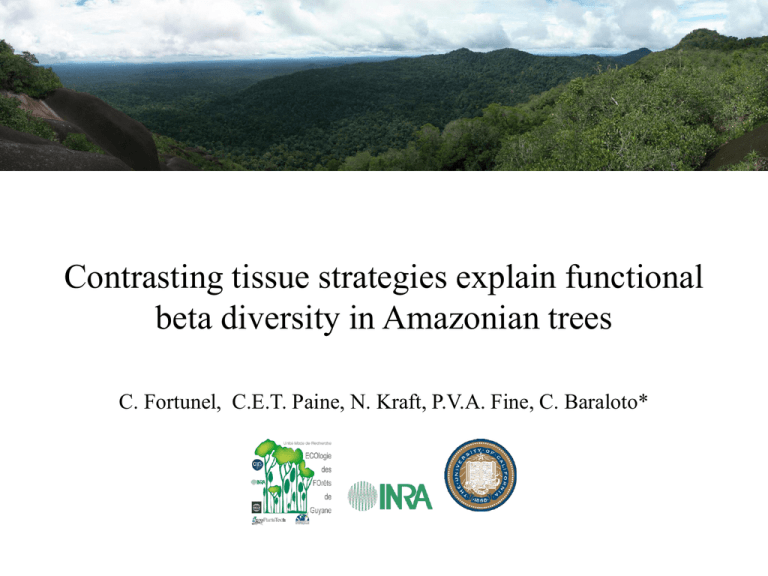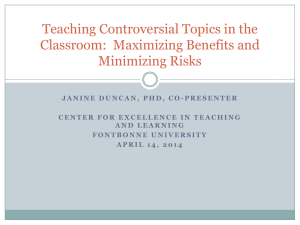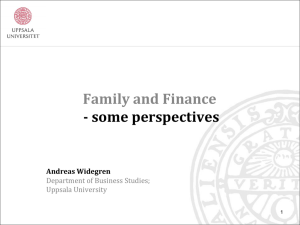Environmental filtering
advertisement

Contrasting tissue strategies explain functional beta diversity in Amazonian trees C. Fortunel, C.E.T. Paine, N. Kraft, P.V.A. Fine, C. Baraloto* Introduction Material and methods Results Conclusion and perspectives Global changes in the tropics • Land use changes through logging, deforestation, fragmentation, and fire use • Climate changes with increases in extreme climatic events (e.g. droughts) Asner et al. 2010. Conserv Lett Lewis et al. 2011. Science Introduction Material and methods Results Conclusion and perspectives Impact on functional diversity • Loss of biodiversity, especially in the tropics, with consequences for ecosystem services Fig. 2. Mean shifts in the geographic variation of functional richness (FR) between present-day (1960–1989) and future climate scenarios (2070–2099) B1 (a) and A2 (b). FR increase and decrease is calculated relative to FR of present-day climates. Reu et al. 2011. Biogeosciences • Predictions of loss of functional diversity limited by poor description of spatial patterns Introduction Material and methods Results Conclusion and perspectives Community assembly Niche-based processes Regional species pool Stochastic processes Species functional strategies Speciation rate Environmental filtering Dispersal limitation Niche differentiation (limiting similarity) Density-dependent mechanisms (e.g. Janzen-Connell) Demographic stochasticity Local community Introduction Material and methods Results Conclusion and perspectives Community assembly and species traits • Trait = any morphological, physiological or phenological feature measurable at the individual level (Violle et al. 2007. Oikos) Reproduction Survival Fitness Growth • Traits reflect tradeoffs that determine • Species performance in a given environment • Species abundances along environmental gradients • Importance of environmental filtering Ex: environmental filtering on SLA Kraft et al. 2008. Science To what extent environmental filtering has predictable consequences on the functional composition of communities across the landscape? Introduction Material and methods Results Conclusion and perspectives Functional strategies of tropical trees leaf – stem economics leaf – wood (stem/root) economics 668 species, French Guiana 800 species, French Guiana and Peru (project BRIDGE) (project AmaLin) 1.0 0.8 Dim 2: 15.45 % S wood D R wood D 0.6 SLA LNC 0.4 0.2 LKC LPC 0.0 1.0 0.8 0.6 0.4 L13C0.2 LTD 0.2 0.0 LCC LChl 0.2 thick Bark 0.4 0.6 0.8 1.0 LC.N Lthick Ltough 0.4 LA R wood H S wood H 0.6 0.8 1.0 Dim 1: 23.02 % Baraloto et al. 2010. Ecology Letters Fortunel et al. submitted Introduction Material and methods Results Conclusion and perspectives Prediction of direction of environmental filtering wood economics (stem/root) leaf economics Regional pool (trait distribution) Wood density Terra firme TF Seasonally flooded SF White sand WS SLA Introduction Material and methods Results Plot network of AmaLin project 74 plots Modified-Gentry French Guiana and Peru Baraloto et al. 2011. Global Change Biology Conclusion and perspectives Introduction Material and methods Results Conclusion and perspectives Three contrasting habitats across a broad environmental gradient Terra firme (TF) • • Seasonnally flooded (SF) Botanical records (species identification and abundance) Description of environmental factors (climate and soil) Environmental factors Plots per habitats White sand (WS) Introduction Material and methods Results Conclusion and perspectives Functional trait measurements For each species in each plot, traits were measured at the level of: • Leaf SLA, LA, toughness, thickness, LTD, LChl, LCC, LNC, LC:N, LPC, LKC, L 13C, L 15N • Stem wood density, humidity • Trunk bark thickness • Root wood density, humidity Introduction Material and methods Results Conclusion and perspectives Evaluation of environmental filtering Regional species pool (FG or Peru) For each of 13 plots • Species traits • Species abundance Focal plot (number of individuals=x) Observed community functional composition • Community-weighted mean • Convex Hull volume Random assemblage function of species abundances irrespective of species traits 999 random communities (equal number of individuals x) Predicted distribution of community functional composition • Community-weighted mean • Convex Hull volume Introduction Material and methods Results Conclusion and perspectives Environmental filtering on community functional composition wood economics TF G4 SF G8 WS G2 leaf economics Introduction Material and methods Results Conclusion and perspectives Density Density Environmental filtering on community functional composition CH overlap CH overlap Introduction Material and methods Results Conclusion and perspectives Directional shifts in community functional composition across the Amazonian landscape Environmental filtering for denser leaf, stem and root tissues in dry and poor environments. Terra firme (TF) Seasonnally flooded (SF) Wood density or 1/SLA White sand (WS) Wood density or 1/SLA Introduction Material and methods Results Perspectives • Implications for modeling community shifts across the landscape • Implications for ecosystem services under global changes scenarios Conclusion and perspectives Research was supported by a collaborative NSF DEB-0743103/0743800 to CB and PVAF and by an INRA Package grant to CB.








